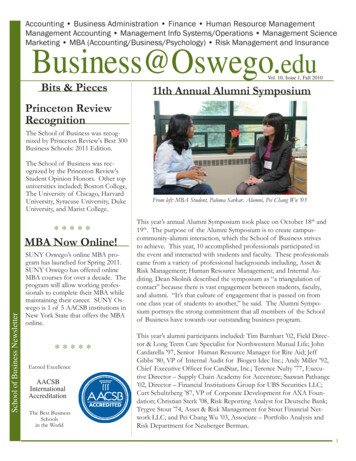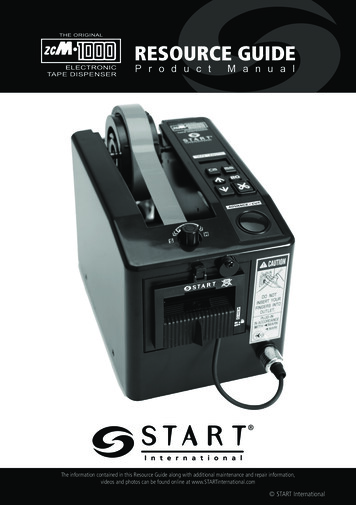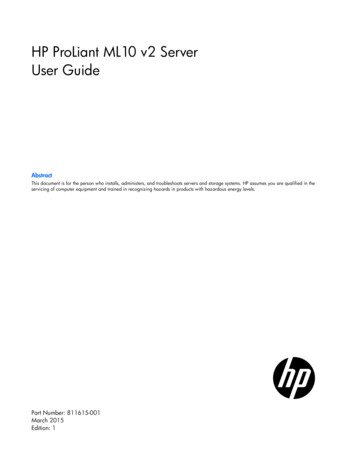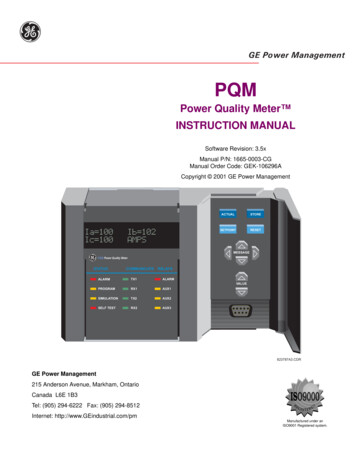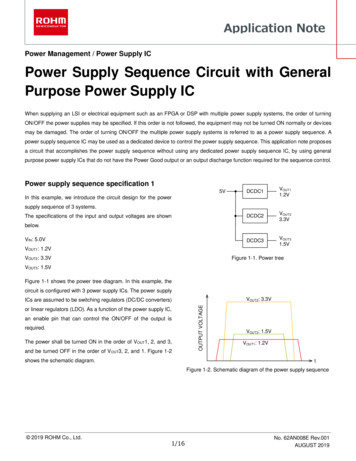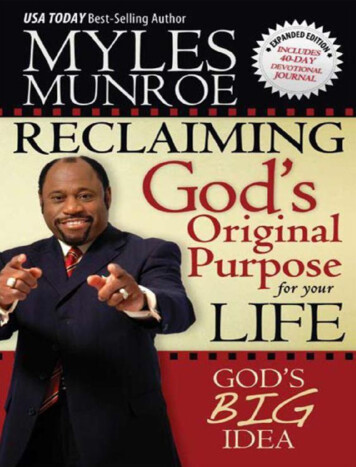
Transcription
Power of Purpose Symposium.Does purpose impact stakeholderand shareholder value?INSTITUTEApril 2017
Contents Introduction – Gillian Secret and Cynthia CherreyKey Findings - Key Symposium Themes & Stakeholder ImpactsLeadership: Person or Purpose? – Prof. Georgia SorensonThe Process – Bringing Practitioners and Scholars TogetherWhite Paper – Ali JonesGoing Forward – Further Research and Practice – Avenues Gillian Secrettand Cynthia Cherrey The Møller Institute and the ILA: Our Partnership – Prof. Georgia Sorenson2 Power of PurposePower of Purpose 3
Introduction: CEOs andThought Leaders Explorethe Power of PurposeDoes purpose impact stakeholder andshareholder value?This was the compelling question explored at the joint symposium between theInternational Leadership Association and the Møller Institute on 20 and 21 April, 2017. Thesymposium was convened for corporate leaders and leadership scholars from around theworld. In particular, they were charged to discuss the importance of company purpose inthe context of the United Nations’ Sustainable Development Goals.The symposium provided an opportunity to explore the power of purpose in a practicalsense, and provided a living example of bringing theory and practice together to expand theboundaries of thinking on the subject. It also allowed us to discover new ways leaders mightdevelop their own workplaces and leadership research using the power of purpose.CEOs and HR Directors from diverse organisations including DLA Piper, Unilever,AstraZeneca, Lidl UK, Marshall Group, Trustonic, Taylor Vinters, Friends of the Earth,Scandinavian Airlines, and the Babraham Institute joined in the discussion and drilled downwith case studies from AstraZeneca and DLA Piper on their organisations’ work on infusingtheir company with purpose.practice and discussed the implications of singularly focusing upon corporate purpose tothe exclusion of societal purpose against the backdrop of the complex, competitive, andunpredictable world we now live in.The CEOs, HRDs, and leadership scholars worked in facilitated discovery workshops toshare valuable experiences and initiatives that they had found create momentum andengagement and to address what purpose meant to them individually and to theirorganizations. They also explored how purpose can generate value for a range of keystakeholders.The following paper outlines their collective work. It begins with an Executive Summary ofkey findings from the symposium followed by an article by Georgia Sorenson on why today’sleadership is about purpose-led companies. You then will get a glimpse into the process ofthe symposium before getting into the rich content and outcomes in the white paper. Thedocument concludes with what more needs to be done.We look forward to continuing this journey forward with our business and leadership scholarcolleagues as we discover the extraordinary impact of purpose-led organizations.Sincerely,Gillian Secret, CEO, Møller InstituteCynthia Cherrey, CEO, International Leadership AssociationInternationally renowned leadership scholars flew to Cambridge from the U.S., Denmark,New Zealand, Sweden, Mexico, Australia, and Scotland to share their newest researchfindings on purpose-driven organizations. Møller Leadership Scholar Georgia Sorenson wasjoined by Gill Robinson Hickman from the Jepson School of Leadership Studies, to explainthe construct of their book The Power of Invisible Leadership and how people align withorganisations that have a compelling and deeply held common purpose that inspires themto deliver their best work. Steve Kempster, coming a shorter distance from the Universityof Lancaster, and Brad Jackson, traveling from New Zealand’s School of Government at theVictoria University of Wellington, explored leadership as purpose and its role in leadership4 Power of PurposePower of Purpose 5
Key Findings – KeySymposium Themes &Stakeholder ImpactsPurpose as a Nexus of Theory and PracticeThe symposium illuminated the critical role of purpose as a unifying factor for successfulorganizations, as well as individuals and leaders. Purpose offers a unique bridge betweentheory and practice, as it provides a theoretical model or frame by which business practicemight be planned, completed, and assessed. This model also allows individuals to align theirown core values to those of their organizations. On the macro level, purpose transformsorganizations into leaders who are now able to align practice with conscious intent viadetermined value sets. As a result, leadership theories might be used to understand,improve, and interpret the conscious practice of organizations that currently have a vastarray of theory at their disposal for the improvement of purpose-driven-leadership practice.This new reality bridges the boundary between theory and practice, and could allowpurpose to establish itself as a nexus in this important relationship.Leadership: Purpose Drives Every Leader Understanding purpose could offer a vital method for uncovering the truth about whatallows great leaders to emerge. Organizations must define what their intended impact is in the long term. Leadership is about creating a sense of shared purpose and embracing the bigger picture,which a purpose-driven company will do in a driven and focused manner. Shared purpose implies shared leadership. Purpose needs to be sustainable beyond the tenure of a leader, and therefore must beshared across an organization. Purpose often originates in the vision of the founder. In other contexts, it may extendbeyond that individual, and it will ultimately need to. It could even change and evolve withthe introduction of a new leader.Growth: Purpose Motivates Personal and OrganizationalGrowth Purpose can offer a catalyst of organizational change to improve society as well as a returnon investment for shareholders. Purpose focuses the mind and business practice, particularly in relation to thinkingstrategically. People often have a core calling, which may define their personal purpose. This will alignwith organizational choice. Results are particularly powerful when personal purpose is aligned with organizationalpurpose.6 Power of Purpose In the public sector where resources are scarce, organizational purpose has a particularlymotivating role. Purpose drives a sense of joint achievement that unites and motivates. Purpose can be seen as an example of expectancy theory, where people create a vision thatthey can identify with, and this provides a positive framework to attract people and pullthem in. Purpose is a way of working collectively and creating engagement. Individuals can connect with organizational purpose at an intellectual and an emotionallevel – giving sense to purpose is therefore really important for clear understanding.Employees: Purpose Can Unite the Workforce and InspireEmployee Engagement Personal and organizational purpose amounts to “why you do what you do, and to what enddo you do it?” Purpose offers a new way of connecting many employees at all levels toward a communalgoal and project. Purpose can be an emotional trigger that encourages people to bring their whole selves towork. Purpose can be translated across a global organization, even when located in differentgeographies. An effective purpose can provide the sense that all stakeholders are being served andvalued. Purpose can provide a means of convergence between multiple stakeholders, even withdiffering priorities.Investors and Shareholders: Purpose Increases Profit Driving a brand from a stance of strong purpose and values can also drive profit. The management of shareholder expectations is fundamental to the scale and effectivenessof purpose, and is particularly relevant to short, medium and long term planning, profit, andinvestment. Can purpose still stand when it comes up against commercial objectives? Getting purpose right can help improve companies’ chances of financial success, especiallyvia employee engagement.Community and Environment: Purpose Brings Societal Valueand Impact Defining purpose is about defining one’s role in society. Purpose is bigger than any one individual and can be seen as creating a shared value in andfor a community. A common purpose is often relied upon to try make the world a better place, and topreserve and benefit all aspects of it. Purpose can align a company around the Sustainable Development Goals. Organization purpose is values driven. A responsible purpose driven approach can increase profits via environmentally consciousinnovation.Power of Purpose 7
Leadership:Person or Purpose?By Georgia SorensonGeorgia Sorenson is a Møller By Fellow and Leadership Scholar at Churchill College,University of Cambridge, UK. She founded the James MacGregor Burns Academy ofLeadership at the University of Maryland, US, where she was a Distinguished ResearchProfessor. She is cofounder of the International Leadership Association and has also servedas senior policy analyst in the Carter White House, and Inaugural Chair and Professor ofTransformational Leadership of the US Army War College.Forget about romanticized and heroic leaders. Today’s leadership is all aboutpurpose-led companies that are organized or branded around an idea.Both the quest for the perfect leader – be it “the romance of the leader” followed shortlyin the literature by “the romance of the follower” – have become nearly obsolete in today’sbusiness climate.It is really not about leaders or followers anymore. It’s bigger than that. In many ways, wehave been looking for leadership in all the wrong places. Leadership involves people, yes,but ultimately transforming leadership is not about people – whether leaders or followers –but about values and ideas.My co-author and friend James MacGregor Burns, architect of the concept oftransformational leadership, pointed the way to purpose-led leadership by introducing“values-added” to a marketplace focused on “value-added.”Burns was a “values” man to the core and opened his classic book Leadership with this boldassertion: “ leadership occurs when one or more persons engage with others in such away that leaders and followers raise one another to higher levels of motivation and morality.Their purposes, which might have started out as separate but related, as in the case oftransactional leadership, become fused. Power bases are linked not as counterweights butas mutual support for common purpose.” Leadership is meaningless, Burns said, without itsconnection to common purposes and collective needs.8 Power of PurposeFlash forward 40 years. The concept of purpose-led companies – companies organized orbranded around an idea – has been at the forefront of debate about the new work force, thenew consumer and, increasingly, the new investor.Millennials in particular, as consumers, employees and citizens, are at the forefront of thisfocus. Mark Zuckerberg, CEO of Facebook and Time magazine’s “most influential millennial”closed his recent Harvard commencement address saying: “To keep our society movingforward, we have a generational challenge – to not only create new jobs but also create arenewed sense of purpose.”And he challenged the graduates: “Let’s do big things, not only to create progress but tocreate purpose. So, taking on big meaningful projects is the first thing we can do to create aworld where everyone has a sense of purpose.”Zuckerberg joins other global innovators such as Bob Forrester, CEO of Newman’s Own,which donates 500 million a year to charities, and Jostein Solheim, CEO of Ben and Jerry’s,on the purpose platform. These and other companies – Warby Parker’s commitment todonate glasses to the poor and Unilever’s “Making Sustainable Living Commonplace,” forexample – are purpose-led from the outset.Companies are increasingly migrating to purpose-led leadership, including long-standingentities such as Campbell’s Soup, where CEO Denise Morrison is now leading the industry iningredients transparency and promoting healthy communities.The business revolution is shaking things up and business schools are scrambling to createcurricula that reflect that change.In an article this year by Mie Augier and Arjay Miller in AACSB International’s BizEd magazine,the authors trace the trajectory and history of American business school curricula and makea compelling case that business schools need to do more than add stand-alone ethics,values and social responsibility courses to their curricula.Arguing that the corporation of the future is interested in both profit and purpose, theystate: “We know that it is easier to teach students how to make money than how to solvesocial problems. After all, problems such as climate change, education and healthcareare too complex for an algorithm to handle. But if schools can add dimensions of socialconsciousness to their existing core curricula, they can help students think through howthey and their organizations can help address large social issues on a regional, national orglobal scale.”Ulrich Hommel and Michel Osbaldeston’s discussion in a recent issue of GlobalFocus magazine goes even further by suggesting that the accreditation process will help tokeep business schools relevant and current.Power of Purpose 9
The Møller Institute at Churchill College, University of Cambridge, in the UK and theInternational Leadership Association (ILA) share a common passion: to facilitate learning andpractice that is designed to support practical leadership.Cynthia Cherrey, President of ILA, summarizes her commitment to scholar-CEO dialogue:“There is a greater calling for businesses to be dedicated to a compelling and deeply heldpurpose for the greater good of individuals, communities and societies. Corporate learningand organizational purpose is at the nexus of theory and practice. Innovative thinking andnew ways of working and leading occur by bringing together the best thought leaders –the CEOs and the leadership scholars – to generate a rich series of conversations, forwardthinking practices and concepts to inform the important work on purpose-led businessorganizations.”To that end, Møller and ILA are sponsoring a series of Practical Leadership Symposiums onthe Power of Purpose. The next symposium will be 13-14 December 2018 at the MøllerInstitute.The first symposium this year brought together 70 business leaders and researchers andproduced a white paper structured around two questions: “What does purpose meanto you in your organization/experience?” and “How does purpose generate value for allstakeholders?”The symposium utilized our book (The Power of Invisible Leadership: How a CompellingCommon Purpose Inspires Exceptional Leadership, Hickman, G R and Sorenson, G L. ThousandOaks: Sage Publications 2013) and our earlier research.My co-author, Gill Hickman, and I found that once a business or group is aligned under acommon purpose, it can function as a unified whole. Our research, utilizing 21 companiesselected from World Blue Award-winning companies, found that purpose-led companiesattracted individuals inspired by its purpose, who stayed longer and were happier. And theircompanies were more successful and profitable than more traditional workplaces.These findings were later replicated in a survey, titled The Business Case for Purpose, inwhich a team from Harvard Business Review Analytics and professional services firm EY’sBeacon institute concluded “ those companies able to harness the power of purpose todrive performance and profitability enjoy a distinct competitive advantage.”The symposium used researcher Steve Kempster’s framework for stakeholders shaping thesuccess of every purpose-led organization, including: Shareholders and investors Employees and unions Partners/suppliers/resources Customers Community The Environment (or what Kempster calls, “One Planet”)In the words of social entrepreneur and symposium participant Béla Hatvany, in an alignedpurpose-led organization each stakeholder must feel well served and well rewarded.Through a process he calls “inquiry,” Hatvany was an early pioneer in assuring that the sectorsin his purpose-led companies were, as he says, “well nourished.”In short, the recent symposium was a rich environment to explore the intersection betweenthe research and practice of purpose-led businesses.Gillian Secrett, CEO of the Møller Institute, concluded: “The symposium illuminated thecritical role of purpose as a unifying factor for successful organizations, as well as individualsand leaders. Purpose offers a unique bridge between theory and practice as it provides atheoretical model or frame by which business practice might be planned, completed andassessed. This model also allows individuals to align their own core values to those of theirorganizations.“On the macro level, purpose transforms organizations into leaders that are now able to alignpractice with conscious intent via determined value sets. As a result, leadership theoriesmight be used to understand, improve and interpret the conscious practice of organizationsthat currently have a vast array of theory at their disposal for the improvement of purposedriven leadership practice. This new reality bridges the boundary between theory andpractice, and could allow purpose to establish itself as a nexus in this important relationship.”Cambridge researcher Ali Jones, in a white paper at the first purpose symposium, endedher work by citing the college’s namesake: “As Winston Churchill once expressed it: ‘it iswonderful what great strides can be made when there is a resolute purpose behind them’.”Whether in wartime or in business, we agree.This article was originally published in EFMD’s Global Focus magazine and is reprinted with theirpermission.10 Power of PurposePower of Purpose 11
The Process – BringingPractitioners andScholars TogetherThe process of bringing together international scholars and CEOs from major corporations,accompanied by their Human Resource Directors, sits naturally in this context and providesboth the culture and environment for creative and productive debate. Scholars andpractitioners convened for dinner to start the conversation in an informal way and werewelcomed by the Master of Churchill College, Professor Dame Athene Donald. The followingday the symposium was launched by ILA President and CEO, Cynthia Cherrey, and MøllerCEO, Gillian Secrett, and was facilitated by Ruth Berry from the Møller team.The ambition for the symposium was to learn from each other by considering relevantacademic research as well as on the ground corporate practice. Short “words of wisdom” orWOW talks were presented and used to stimulate discussions on the important question ofpurpose. Delegates worked in ten-table groups of scholars and practitioners, each with aMøller facilitator and scribe. The agenda was structured around two meta questions, the firstof which was posed in the morning: “What does purpose mean to you in your organization/experience?” This discussion was coloured by two WOW talks.The first WOW talk was given by Dr. Mene Pangalos, EVP of Innovative Medicines and EarlyDevelopment at AstraZeneca. Pangalos focused on scientific partnership and the evolutionof AstraZeneca’s culture after the company defined its purpose. This unifying goal wasformulated as: “We push the boundaries of science to deliver life-changing medicines.”Pangalos reported CEO Pascal Soriot’s words that, “together, we can be confident that, byleading in science, we will transform the lives of patients around the world. ” This case studyprovided a very powerful example demonstrating how engagement and success can bedriven by purpose, as underpinned by a strong set of values that everyone can engagearound.12 Power of PurposeThe second WOW talk was from ILA Lifetime Achievement Award Winners Professor GeorgiaSorenson (also a Møller Leadership Scholar) and Professor Gill Robinson Hickman. Aspresented in their book The Power of Invisible Leadership (2014), they shared the findings fromtheir research question, “Can a common purpose actually inspire leadership?” Sorensonand Hickman tested this thesis in studies of 21 award-winning companies and discoveredthat, “the common purpose, rather than any particular individual, is the invisible leaderthat inspires leaders and followers to take action on its behalf.” Using a Factor Analysisthey identified four significant factors underlying invisible leadership: Collective Capacity;Internalized Purpose; Role Flexibility; and Purpose Inspired Dedication and Accountability.Their advice to the organizational leaders present was to “cultivate purpose as a livedexperience.”The discussion that followed explored the current theory and practice experience of eachgroup, and the key findings were fed back into the group.The second meta question was posed in the afternoon: “How does purpose generate valuefor all stakeholders: customers; shareholders and investors; employees and unions; partners/suppliers/resources; society and environment (one planet)?” Delegates re-grouped with eachtable representing one stakeholder group for discussion purposes. Each delegate assumedthe role of one stakeholder group and conversations were stimulated by the introductionof WOW talk three: “How does purpose create value and engagement for employees?” Thiswas presented by Simon Levine, Managing Partner and Global co-CEO of DLA Piper LLP, whofocused on live case studies within his own organization.WOW talk four was given by scholars Professor Steve Kempster and Professor Brad Jacksonwho built on Keith Grint’s framework of leadership as Person, Performance (Results), Positionand Process (2005) through the addition of Place and Purpose. In the context of the U.N.Sustainable Development Goals, Kempster discussed the importance of “responsibleleadership ”for purpose oriented organizations. He posits that this can be facilitated viamaximizing fiduciary duty through a system of six “good dividends” (Kempster 2016).Delegates then moved into groups comprising all stakeholders to consider the system as awhole, focusing on a particular corporate sector case to test if purpose really can drive valuefor all stakeholders.Power of Purpose 13
Visual summary of keythoughts and ideas 2017 Møller Institute. All Rights Reserved.14 Power of PurposePower of Purpose 15
White PaperIntroductionThe Møller Institute at Churchill College and the ILA held a joint Practical LeadershipSymposium, which brought together business leaders, academic researchers, and subjectexperts for a full day discussion of the Power of Purpose.The concept of purpose-led companies has been at the forefront of debate about thenew work force, the new consumer, and increasingly, the new investor (Sachs 2016). MarkZuckerberg, CEO of Facebook, closed his 2017 commencement speech at Harvard Universitywith the need to infuse purpose into our work and personal lives, declaring: ‘Let’s do bigthings, not only to create progress, but to create purpose’ and also argued that ‘taking onbig meaningful projects is the first thing we can do to create a world where everyone has asense of purpose.’The symposium, held at the Møller Institute, Churchill College in the University ofCambridge, was structured around two meta questions, each of which was addressed bytwo presentations. The first set the tone for the day by relying on the practical knowledgepresent in the room by asking: ‘What does purpose mean to you in your organisation/experience? ’ The second then built on this accumulated expertise by applying thisknowledge to new practice, investigating: ‘How does purpose generate value for allstakeholders: customers; shareholders and investors; employees and unions; partners/suppliers/resources; society and the environment?’The participants were grouped in tables and were tasked with exploring these meta issues,both by relying on their own companies’ experiences, as well as by proposing new ideasusing the proposed framework of purpose. The symposium organisers established thismodel based on the leadership theory of James MacGregor Burns and presenters GillHickman, Brad Jackson, Steve Kempster, and Georgia Sorenson.Building on this academic expertise and applying it to the practice knowledge-set in theroom, the symposium brought together leadership theory and purpose-led practice tooffer new insights on purpose-led alignment in organisations. Such newly aligned groupsalso embody the personality and identity of their purpose, almost as an individual leadermight, allowing these groups to benefit from the application of transformational leadershippractice.ContextPurpose in business leadership is a largely understudied field. Early work by Hickman andSorenson, (2001, 2004, 2013) found that once a business or group are aligned under acommon purpose, they can function as a unified whole. Their research utilized 21 companiesselected from WorldBlu award winning democratic companies, and they found thatpurpose-led companies attracted purpose-aligned individuals, who stayed longer, werehappier. These companies were also more successful and profitable than more traditionalworkplaces (2013).Steve Kempster’s (2011) work is another of the few studies to recognize purpose as animportant area in the study of management, in addition to a new application for traditionalfocuses on leadership. Another leadership scholar Keith Grint (2005) developed a usefulheuristic identifying leadership as fourfold: Person, Process, Position, and Results. However,Kempster suggests adding Purpose as a fifth category, and offers a repurposed six-foldschema of: Position, Person, Performance, Process, Place and Purpose (2017). His work furtherplaces the importance of leadership and purpose in the context of the 2008 credit crunch,and argues against Friedman’s (1967) vision that:Business has only one social responsibility ‘to use its resources to increase its profits solong as it stays within the rules of the game, which is to say that it engages in open andfree competition without deception and fraud. In a sense, an amoral perspective in whichthere is no place for moral considerations in the corporate context. From this perspectiveall corporations relentlessly pursue maximum profits. A director cannot and may not allowhimself moral standards.1In contrast, in light of the new business landscape after the 2008 recession, Kempster arguesthat the values of leadership are now more relevant than ever. In fact, the symposiumfound that the recession has refocused public and consumer opinion on the values ofbusiness, and that the accompanying public purpose plays an increasingly important rolein consumer support. Even Forbes has noted this transition, and has argued that companieswith clear moral codes will come to dominate the market share (Sachs 2016). Corporatepurpose and personality are now intrinsic factors in economic decision making, and thesedriving value sets must be carefully crafted and established for businesses to continueprospering under these new conditions.This recent societal change is in fact not a surprise, but rather only represents the latest ina historical generational value shift. Sociologist Ronald Inglehart (1977) famously arguesthat post-war generations have adopted a ‘post-materialist’ value set. He explains thatKaptein and Wempe, 2002: 116, in Steve Kempster, Brad Jackson, and Mervyn Conroy, ‘Leadershipas purpose: Exploring the role of purpose in leadership practice’, Leadership, 7(3) pp. 317–334, 2011.116 Power of PurposePower of Purpose 17
the priority earlier placed on ‘material’ goods and economic stability, as demonstrated bymany wartime adults, has ultimately fostered a new generation raised in relative economicsecurity, free from the deprivations of wartime generations. Thus, they no longer share theirparents’ need to prioritize economic security to the exclusion of a deeper consideration ofthe environment, working conditions, and personal fulfilment. This new generation thereforevalues these ‘post-material’ or moral and ethical goods more than financial gains or physicalpossessions. This generational clash can be further witnessed in what are today known as‘millennials’ – a term that fails to consider the gradual shift in societal values towards postmaterialism since at least 1968. These new value sets parallel economic changes fromindustrial production to knowledge-based, marketing, or other ‘soft’ industries, especiallyafter the deregulation and relocation of mining and other hard industries under the Thatcherregime. As businesses transform away from producing ‘hard’ material goods and towards‘soft’ identity grounded concepts and services, such as advertising, consulting, marketing,etc., many consumers now are primarily interested in the identity and purpose of a company.This identity includes what a business stands for, who they are, how they are a positive andresponsible member of society, where their goods come from, and other sustainabilityfactors.Symposium participants suggested that this value-set can also be thought about as abusiness’ personality, which is demonstrated through its purpose. New consumers care aboutthe experience of doing business with someone almost as much as they do about the finalproduct received. They will choose to interact with the business with the most compatiblepersonality, for the best consumer experience. This can include things like customer service,but also returns policies, front line staff’s attitudes, a small environmental footprint, as well asthe clearly communicated values of an organization.The example of the Body Shop was provided by one symposium participant as a companywith a clear purpose. Another suggestion was a spa-hotel, whose staff paid extra careto make guests feel pampered and welcome. These extra touches demonstrate boththe personality of the organizations, as well as the purpose – be it a
6 Power of Purpose Power of Purpose 7 In the public sector where resources are scarce, organizational purpose has a particularly motivating role. Purpose drives a sense of joint achievement that unites and motivates. Purpose can be seen as an exampl


